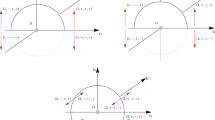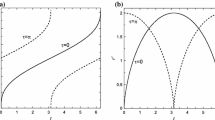Abstract
Some comet- and Hill-type families of nearly circular symmetric periodic orbits of the elliptic restricted three-body problem in the inertial frame are numerically explored by Broyden’s method with a line search. Some basic knowledge is introduced for self-consistency. Set \(j/k\) as the period ratio between the inner and the outer orbits. The values of \(j/k\) are mainly \(1/j\) with \(2\leq j\leq 10\) and \(j=15,20,98,100,102\). Many sets of the initial values of these periodic orbits are given when the orbital eccentricity \(e_{p}\) of the primaries equals 0.05. When the mass ratio \(\mu =0.5\), both spatial and planar doubly-symmetric periodic orbits are numerically investigated. The spacial orbits are almost perpendicular to the orbital plane of the primaries. Generally, these orbits are linearly stable when the \(j/k\) is small enough, and there exist linearly stable orbits when \(j/k\) is not small. If \(\mu \neq 0.5\), there is only one symmetry for the high-inclination periodic orbits, and the accuracy of the periodic orbits is determined after one period. Some diagrams between the stability index and \(e_{p}\) or \(\mu \) are supplied. For \(\mu =0.5\), we set \(j/k=1/2,1/4,1/6,1/8\) and \(e_{p}\in [0,0.95]\). For \(e_{p}=0.05\) and 0.0489, we fix \(j/k=1/8\) and set \(\mu \in [0,0.5]\). Some Hill-type high-inclination periodic orbits are numerically studied. When the mass of the central primary is very small, the elliptic Hill lunar model is suggested, and some numerical examples are given.







Similar content being viewed by others
References
Bolotin, S.: Celest. Mech. Dyn. Astron. 93, 343 (2015)
Broucke, R.A.: Celest. Mech. Dyn. Astron. 81, 321 (2001)
Broyden, C.G.: Math. Comput. 19, 577(92) (1965)
Chenciner, A.: Henri Poincaré, 1912–2012 In: Duplantier, B., Rivasseau, V. (eds.) Poincaré and the Three-Body Problem. Birkhäuser, Basel (2015)
Cors, J.M., Pinyol, C., Soler, J., Physica, D.: Nonlinear Phenom. 154, 3–4 (2001)
Cors, J.M., Pinyol, C., Soler, J.: J. Differ. Equ. 219, 1 (2005)
Farantos, S.C.: Comput. Phys. Commun. 108(2–3), 240 (1998)
Galan-Vioque, J., Almaraz, F.J.M., Macías, E.F.: Eur. Phys. J. Spec. Top. 223, 2705 (2014)
Gómez, G., Ollé, M.: Celest. Mech. 39, 33 (1986)
Gomez, G., Olle, M.: Celest. Mech. Dyn. Astron. 52, 107 (1991)
Haghighipour, N., Dvorak, R., Pilat-Lohinger, E.: In: Haghighipour, N. (ed.) Planetary Dynamics and Habitable Planet Formation in Binary Star Systems, p. 285. Springer, Dordrecht (2010)
Hénon, M.: Generating Families in the Restricted Three-Body Problem. Springer, Berlin (1997)
Koh, D., Anderson, R.L., Bermejo-Moreno, I.: J. Astronaut. Sci. 68, 172 (2021)
Kotoulas, T., Voyatzis, G.: Astron. Astrophys. 441, 807 (2005)
Llibre, J., Piñol, C.: Celest. Mech. Dyn. Astron. 48, 319 (1990)
Meyer, K.R., Hall, G.R., Offin, D.: Introduction to Hamiltonian Dynamical Systems and the N-Body Problem. Springer, Berlin (2009)
Ollé, M., Pacha, J.R.: Astron. Astrophys. 351, 1149 (1999)
Palacián, J.F., Yanguas, P., Fernández, S., Nicotra, M.A.: Phys. D: Nonlinear Phenom. 213(1), 15 (2006)
Pan, S.S., Hou, X.Y.: Res. Astron. Astrophys. 22, 072002 (2022)
Peng, H., Xu, S.J.: Celest. Mech. Dyn. Astron. 123(3), 279 (2015)
Peng, H., Bai, X.L., Xu, S.J.: Commun. Nonlinear Sci. Numer. Simul. 47, 1 (2017)
Press, W.H., Teukolsky, S.A., Vetterling, W.T., Flannery, B.P.: Numerical Recipes in Fortran 77, the Art of Scientific Computing. Cambridge University Press, New York (1992)
Sarris, E.: Astrophys. Space Sci. 162, 107 (1989)
Sheth, D., Thomas, V.O.: Astrophys. Space Sci. 367, 99 (2022)
Szebehely, V.G.: Theory of Orbits. Academic Press, New York (1967)
Tsirogiannis, G.A., Perdios, E.A., Markellos, V.V.: Celest. Mech. Dyn. Astron. 103(1), 49 (2009)
Voyatzis, G., Gkolias, I., Varvoglis, H.: Celest. Mech. Dyn. Astron. 113(1), 125 (2012)
Xu, X.-B.: Chin. Astron. Astrophys. 64(4), 40 (2022)
Xu, X.-B.: Celest. Mech. Dyn. Astron. 135, 8 (2023). https://doi.org/10.1007/s10569-023-10121-y
Xu, X.-B., Fu, Y.-N.: Sci. China Ser. G 52(9), 1404 (2009)
Zhao, L.: Math. Ann. (2021). https://doi.org/10.1007/s00208-021-02339-8
Acknowledgements
This first author is supported by the National Nature Science Foundation of China (NSFC, Grant No. 11703006). The second author is supported by Shanghai Observatory’s key cultivation project (N20210601003), Civil Aerospace “14th Five-Year” Technology Pre-research Project (KJSP2020020203). The authors would like to thank the reviewers of this paper for their constructive comments and suggestions.
Author information
Authors and Affiliations
Contributions
The first author Xu wrote the paper and calculated the results and contributed most of the ideas. The second author supplied some background for this paper and gave some suggestions. All authors reviewed the manuscript.
Corresponding author
Ethics declarations
Competing interests
The authors declare no competing interests.
Additional information
Publisher’s Note
Springer Nature remains neutral with regard to jurisdictional claims in published maps and institutional affiliations.
Rights and permissions
Springer Nature or its licensor (e.g. a society or other partner) holds exclusive rights to this article under a publishing agreement with the author(s) or other rightsholder(s); author self-archiving of the accepted manuscript version of this article is solely governed by the terms of such publishing agreement and applicable law.
About this article
Cite this article
Xu, XB., Song, YZ. Continuation of some nearly circular symmetric periodic orbits in the elliptic restricted three-body problem. Astrophys Space Sci 368, 13 (2023). https://doi.org/10.1007/s10509-023-04169-3
Received:
Accepted:
Published:
DOI: https://doi.org/10.1007/s10509-023-04169-3




